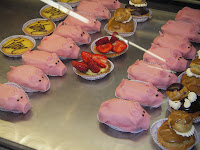


Years ago, the French physique seemed to be defined by a pencil-thin silhouette. Americans marveled—how could a nation that consumed wines, cheeses, and croissants and pastries do it! In her book French Women Don’t Get Fat, the slender Mireille Guiliano addressed this paradox of eating, stressing that French women do not deny themselves certain culinary delights. But they seek quality over quantity and get plenty of exercise. But hélas, did Ms. Guiliano speak too soon? Not all French women look like the svelte, laughing demoiselles remembered by WWII GIs (including my dad) or the shapely bistro bartenders in the tight lace dress.
The image of pencil thin has changed in recent years. Overweight people, who used to be identified as “foreigners,” speak French while they wait in line at French supermarket aisles, walk seaside boardwalks and eat in restaurants. What used to be a lean population has turned into one of expanding waistlines, which has become a matter of national concern! Too much rich food? Au contraire. This phenomenon is blamed on the invasion of junk foods--a shift from eating only at an established meal time to continual grazing. Furthermore, more cars and parking spaces provide less incentive to walk. The average French person of previous years walked to the fresh food markets, dashed to catch a bus and always ran up steps, lugging net shopping bags filled with the day’s purchases. For children, the combination of fast foods (in French, le malbouffe actually means bad food), computer games and television programs has led to the problems of being overweight and obese.
To combat a growing population of obese children (an estimated one in 10), the French government removed vending machines from public schools and initiated a massive campaign, targeting fast foods. Since 2007, all fast-food advertisements carried by the media must advocate healthy eating habits--five fruits and vegetables daily, exercise, avoidance of snacking and foods high in salt and fats. .
But is obesity the fault of McDo (prononced MAC-DOE) and “le Big Mac” or other fast foods? Or is that je ne sais quoi. . . .
Of course, a simple solution exists, one developed by my mom years ago. Before my sister and I could approach the den couch to watch afternoon television, she whisked us outside under any meteorological conditions for “rip and run.” Exercise became part of our lifestyle, and fruits, vegetables and the occasional pretzel, the staple of our snacking and our bag lunches. Of course, we did find ways to circumvent healthly eating. At the school cafeteria, we bartered these raisins, carrots and apples for the occasional indulgence (a Twinkie!). But overall, the "rip and run maxim" and healthy eating has stuck with us.
The French maintain the crisis has leveled off, that the draconian measures to combat the invasion of fast foods are working. . . . Time will tell. When the slender bartenders return to their counters in their form-fitting tops and when the new generation of kids rip and run outside, the crisis may have passed.
If only the U.S. could take such decisive action! This summer in Bay County Florida, Dr. Jason Newsome, the county Health Department director, was forced to resign after he posted anti-doughnut messages and local politicos who owned Dunkin' franchises protested!
ReplyDelete-H.E.